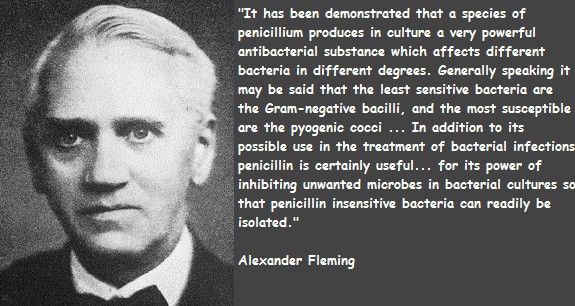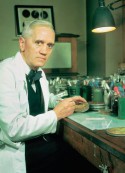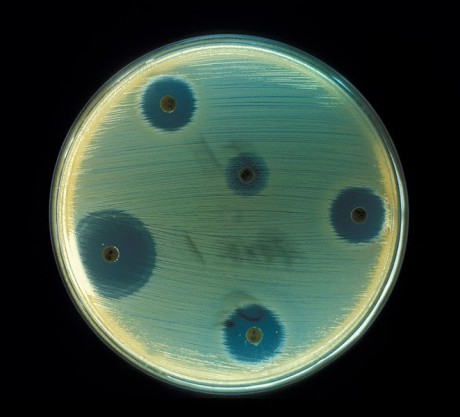Researches
Life of Alexander Fleming was full of incredible circumstances, coincidences and discoveries, enabling them to eventually become world famous, renowned microbiologist and bacteriologist. His successful scientific career began even before the first world war, in which he distinguished himself in the field of surgery, continued in the interwar period in which they were carried out his most significant experiments and ended gets Nobel Prize and elevation to the peerage, peerage to Sir.
Discoveries in youth
As mentioned in the introduction, Fleming's life was full of coincidence. He graduated medical school as surgeon.He was brought to bakteriology by professor Freeman, who didn´t choose him because of his education and skills, but because of the fact that he could shoot and professor Freeman wanted to set up a shooting club. Fleming became part of the laboratory in which he worked all his life. The first big success was determine the primary symptoms of tuberculosis, and ensuring laboratory fame and income. This very promising season ended World War I.
The First World War
Fleming's name during World War showcases again thanks to Professor Wright. Wright was deployed in the lab, which operated in France. He took with him Fleming and Freman. Here has Fleming shown himself as surgeon when he began to practice removing damaged tissue to prevent infection or its possible spread. Professor Wright here proved that the destruction of microbes should be introduced into the wound hypertonic salt solution, which increases the lymphatic drainage of the body. Another important activity of this laboratory finding was that the procedures used to sterilize surgical instruments are not sufficient, and even life and contribute to the growth of bacteria. These findings are important for further development of surgery.
The discovery of lysozyme
This discovery was made in 1922. Fleming took the nasal mucus and placed it in a petri dish, which had previously been colonies of microorganisms that then died. The same thing happened when he placed a tear there. So he decided to investigate and found tears enzyme which he named lysozyme. During the next observation he found that lysozyme does not kill all microorganisms, but only those harmless. But Fleming thought that lysozyme actually determine which microorganisms are pathogenic. Bacteria were killed by the lysozyme in egg white, but nobody could separate it. Therefore Fleming used dilutec egg white and aplied it intravenously to rabbit. Results have been very good, but experiment was very complicated on this time.
Lysozyme (lysis-diluted) is an enzyme that located in the human body or egg white. It has strong antibacterial effects that disrupt the bacterial cell wall.
The discovery of penicillin
It is known that the greatest discoveries and inventions arose and arise by chance. Not otherwise it was in 1928 when the history of medicine was rewritten, without anyone knowing it. Alexander Fleming, in this day, went into the laboratory, where was forgotten Petri dish with the agar (nutrient mixture of red algae, in which the microorganisms are grown), in which was a mold. And in this moment Fleming discovered antibiotic effects of penicillin, concretely fungus Penicillium notata. Substances which are released are killing most bacteria, except those that cause typhoid. Alexander Fleming grew penicillin in broth at 37 ⁰ C. After consulting mycologist this temperature was reduced to 20 ⁰ C. The resulting broth really worked, it killed harmful bacteria but no phagocyt (cell that they can absorb of particles through the membrane). This product worked diluted, but only for a short time. The problem was that no one could separate the substance and broth was as such in medicine unusable. Although Fleming published his discovery, no scientist was interested in his discovery.

Everything changed in 1940, when chemist Ernst Chain andbiochemist Floreymu Howard separeted penicillin and tested it on animals. The results were more than satisfactory. In February 1941, doctors applied penicillin to a man. For lack of substance the patient died, but the medicinal efficacy of penicillin has been demonstrated also on humans. After sufficient accumulation of inventories, penicillin was given three other people. Two patients successfully recovered, the third died from complications.
Unfortunately for Fleming and society, it was during the Second World War. No one could afford to give money in Pharmacy. Therefore Florey decided to go to the U.S., where they tried to grow penicillin on corn, but it failed. The only success was moldy water melon, which became the basis for the production of penicillin in the United States and the first ten thousand liters of penicillin in the world. In 1942, U.S. newspaper published news about this new drug, and a year later pharmaceutical companies started to be interested in it. Chain, Florey and Fleming were given a Nobel prize for medicine 10.25.1945.
Short video about Fleming´s discovery of the " wonder drug" - penicilin:
Jukub Kopřiva

